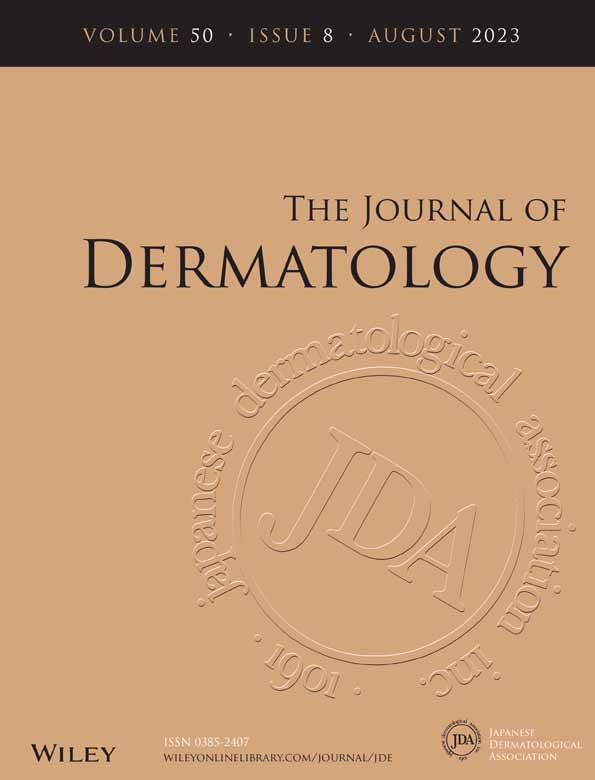Case of type 1 segmental Darier's disease with a novel mosaic mutation in the ATP2A2 gene
Keisuke Shimizu
Division of Cutaneous Science, Department of Dermatology, Nihon University School of Medicine, Tokyo, Japan
Search for more papers by this authorCorresponding Author
Hideki Fujita
Division of Cutaneous Science, Department of Dermatology, Nihon University School of Medicine, Tokyo, Japan
Correspondence
Hideki Fujita, Division of Cutaneous Science, Department of Dermatology, Nihon University School of Medicine, 30-1 Oyaguchi-Kamicho, Itabashi-ku, Tokyo, 173-8610, Japan.
Email: [email protected]
Search for more papers by this authorDaisuke Fujisawa
Division of Cutaneous Science, Department of Dermatology, Nihon University School of Medicine, Tokyo, Japan
Search for more papers by this authorKoremasa Hayama
Division of Cutaneous Science, Department of Dermatology, Nihon University School of Medicine, Tokyo, Japan
Search for more papers by this authorSatomi Aoki
Department of Dermatology, Keio University School of Medicine, Tokyo, Japan
Search for more papers by this authorAkiharu Kubo
Division of Dermatology, Department of Internal Related, Kobe University Graduate School of Medicine, Kobe, Japan
Search for more papers by this authorTadashi Terui
Division of Cutaneous Science, Department of Dermatology, Nihon University School of Medicine, Tokyo, Japan
Search for more papers by this authorKeisuke Shimizu
Division of Cutaneous Science, Department of Dermatology, Nihon University School of Medicine, Tokyo, Japan
Search for more papers by this authorCorresponding Author
Hideki Fujita
Division of Cutaneous Science, Department of Dermatology, Nihon University School of Medicine, Tokyo, Japan
Correspondence
Hideki Fujita, Division of Cutaneous Science, Department of Dermatology, Nihon University School of Medicine, 30-1 Oyaguchi-Kamicho, Itabashi-ku, Tokyo, 173-8610, Japan.
Email: [email protected]
Search for more papers by this authorDaisuke Fujisawa
Division of Cutaneous Science, Department of Dermatology, Nihon University School of Medicine, Tokyo, Japan
Search for more papers by this authorKoremasa Hayama
Division of Cutaneous Science, Department of Dermatology, Nihon University School of Medicine, Tokyo, Japan
Search for more papers by this authorSatomi Aoki
Department of Dermatology, Keio University School of Medicine, Tokyo, Japan
Search for more papers by this authorAkiharu Kubo
Division of Dermatology, Department of Internal Related, Kobe University Graduate School of Medicine, Kobe, Japan
Search for more papers by this authorTadashi Terui
Division of Cutaneous Science, Department of Dermatology, Nihon University School of Medicine, Tokyo, Japan
Search for more papers by this author
REFERENCES
- 1Sakiyama T, Kubo A, Sasaki T, Yamada T, Yabe N, Matsumoto K, et al. Recurrent gastrointestinal perforation in a patient with Ehlers-Danlos syndrome due to tenascin-X deficiency. J Dermatol. 2015; 42: 511–4.
- 2Bachar-Wikström E, Wikström JD. Darier disease—a multi-organ condition? Acta Derm Venereol. 2021; 101:adv00430.
- 3Takagi A, Kamijo M, Ikeda S. Darier disease. J Dermatol. 2016; 43: 275–9.
- 4Sanderson EA, Killoran CE, Pedvis-Leftick A, Wilkel CS. Localized Darier's disease in a Blaschkoid distribution: two cases of phenotypic mosaicism and a review of mosaic Darier's disease. J Dermatol. 2007; 34: 761–4.
- 5Agematsu A, Kamata M, Uchida H, Nagata M, Fukaya S, Hayashi K, et al. A case of type 1 segmental Darier disease showing widespread Blaschkoid skin lesions with p.P160L mutation in ATP2A2. J Eur Acad Dermatol Venereol. 2020; 34: e633–5.




